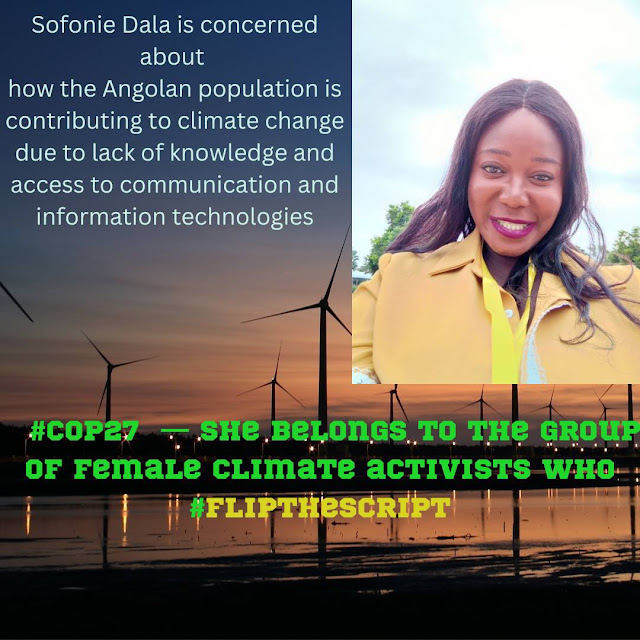Congratulations -The grand finale. The Food You Eat Can Impact Climate Change! By Sofonie Dala, Angola
AFRONUTRI ONLINE
We have the capacity to provide humankind with a healthy, varied diet, and still, almost 700 million people suffer from hunger and 3 billion can’t afford to be well-nourished. At the same time, one-third of all food produced is lost or wasted, a large portion of that within households.
Our Food Choices Can Help Fight Climate Change
Hello, I'm Sofonie Dala!
We are here in the informal kwanza market celebrating the successful conclusion of the 2nd edition of the Afronutri program - healthy food. This program showed us the involvement of vulnerable women in the economic growth of rural areas and the power they have in promoting and transforming sustainable food systems to prevent climate change.
We are here for healthy and sustainable foods.
We're at Dona Maria's counter, she's going to show us what kind of food she sells.
Hello, I have chili pepper here and several types of mushrooms.
Is the food you sell sustainable?
Yes it is very healthy.
What is the health benefit of this food?
There are so many vitamins, oh my God, I'm so excited.
Okay we have a table full of vitamins. The Importance of Not Wasting Food Food is essential for life.
In the following program we will be talking about cassava and its origin. Stay tuned!
The girls next to us are selling eggplant and various types of vegetables. Sustainable nutrition.
Is the food you sell good for health?
Yes, it is very good for our health.
Okay, very well, we MUST choose sustainable foods because they have a big impact on the environment, in our health and in the future generations, they can cause climate change.
The kwanza market is to be congratulated for having women who promote sustainable food systems. As individuals, we can try to stay away from environmentally negative options.
Festival of domesticated manioc
What we eat, and how that food is produced, affects our health but also the environment.
What is this? Is this cassava leaves?
Yes, these are the cassava leaves.
Underneath we can enjoy the cassava. As you can see.
Does cassava grow underneath?
Yes, we can peel cassava, make flour, dry cassava, we can boil cassava and accompany it with mufete, we can drink tea with roasted cassava and peanuts.
We are very happy to have the cassava plant here.
One of the reasons that made me plant cassava was to show my children where cassava comes from. Usually they only watch it on TV and in books.
Is cassava healthy?
Yes, it is very healthy and sustainable. It is a natural plant, the fruit grows underground.
Very good.
We are producing sustainable food.
We are investing in agriculture to end hunger in Africa.
Happy Africa's Year of Nutrition!
We started eating a more plant-rich, balanced diet – one that provides energy and nutrients from several different food groups – and reduced foods that are harder on our planet.
Food needs to be grown and processed, transported, distributed, prepared, consumed, and sometimes disposed of. Each of these steps creates greenhouse gases that trap the sun’s heat and contribute to climate change. More than a third of all human-caused greenhouse gas emissions is linked to food.
Food and climate change: Which foods are the most damaging to the planet? And which foods could help save it?
Generally, whilst choosing organic, local and sustainably packaged options can contribute to a more sustainable diet, they’ll never amount to the same impacts that moving towards a plant-based diet has. The infographic below shows this: the "root" of your impact is the type of food (choosing plant-based vs meat) and the packaging it is in are the "leaves" (a cucumber with or without plastic for example).

The 9 Top Climate Damaging Foods
All foods have an impact, but some have more impact than others, especially when you consider factors like deforestation, biodiversity loss and climate change. Meat and dairy consumption are the main cause of deforestation in the world. Clearing land to raise cattle is not only pushing the Amazon rainforest to a tipping point but also killing wildlife and increasing the risk of future pandemics. More than half of the greenhouse gas (GHG) emissions from food are due to only this one industry. Overfishing is also responsible for huge biodiversity loss.
In other words, how much do different foods contribute to the greenhouse gas effect?
The worst offenders included beef, of course, and also lamb, cheese, pork, farmed salmon, turkey, chicken, canned tuna, and eggs.
Beef production emits about 10 times more greenhouse gases per pound of meat than chickens or pigs, which themselves emit about 10 times more than legumes. The lowest greenhouse gas-producing animal product, chicken, is still seven times more damaging to atmospheric stability than lentils.
#Envision2030
Goal 3: Good Health and Well-Being
Goal 11: Sustainable Cities and Communities
Goal 12: Responsible Consumption and Production
The other 7 you can find partially here in these links:
1. https://sustainablelifestyle-angola.blogspot.com/2022/01/key-takeaways-from-anatomy-of-action.html




Comentários
Enviar um comentário